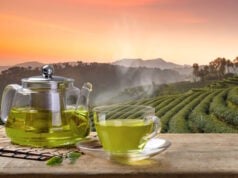
Whether getting one to go or lingering over a second cup, on September 29 be sure to observe National Coffee Day!
Ah, the perfect cup of java. According to an expert cupper (a professional coffee taster), there are four components of a perfect cup: aroma, body, acidity, and flavor.
From the moment the average coffee lover opens a fresh bag of coffee beans, the aroma beckons, percolating the senses. Even those who don’t drink coffee tend to enjoy the fragrance a roasted bean casts.
When determining the body of a coffee, the bean, the roast, and the brew are all factors. The bean affects the texture of the coffee, whether its silky, creamy, thick or thin on the tongue and throat. However, the darker the roast and how it is brewed will alter the feel of a coffee’s body, too. Grandpa’s motor oil blend versus the coffee shop around the corner’s silky smooth, well-practiced grind have entirely different bodies.
The region a coffee is grown determines its acidity. The higher the elevation the coffee grows, the higher the quality and the acidity. These coffees are considered brighter, dryer, even sparkling by cuppers.
When it comes down to it, coffee lovers cherish the flavor as well as the caffeinated boost this roasted bean gives morning or night, black or with cream and sugar. Hot or cold it provides enjoyment even when decaffeinated!
There are many legendary accounts of how coffee first came to be, but the earliest credible evidence of either coffee drinking or the knowledge of the coffee tree appears in the middle of the 15th century in the Sufi monasteries around Mokha in Yemen. It was here coffee seeds were first roasted and brewed, much like they are prepared today. Yemeni traders brought coffee back to their homeland from Ethiopia and began to cultivate the seed.
In 1670, coffee seeds were smuggled out of the Middle East by Baba Budan, as he strapped seven coffee seeds onto his chest. The first plants grown from these smuggled seeds were planted in Mysore (India). It was then that coffee spread to Italy, to the rest of Europe, to Indonesia and the Americas.
Brazil produces more coffee in the world than any other country followed by Colombia. More than 50 countries around the world grow coffee, providing a delicious variety for the indulgence of steamy cups of the black drink for connoisseurs to consume.
Coffee Fun Facts:
- Shepherds discovered coffee in Ethiopia circa 800 A.D. Legend has it that 9th century goat herders noticed the effect caffeine had on their goats, who appeared to “dance” after eating coffee berries. A local monk then made a drink with coffee berries and found that it kept him awake at night, thus the original cup of coffee was born.
- Coffee is the second most traded commodity on earth. According to the Global Exchange, there are approximately 25 million farmers in over 50 countries involved in producing coffee. The number one commodity? Oil.
- Coffee was the first food to be freeze-dried. The process of freeze drying — when fresh foods are placed in a dryer where temperatures drop to negative 40 degrees F — first started during World War II to preserve foods
- Hawaii is the only state in the U.S. that commercially grows coffee. Kona coffee is the United States’ gift to the coffee world. Because coffee grows best in climates along the equator, Hawaii’s weather is optimal for harvesting coffee beans.
- Coffee was originally a food. Coffee berries were mixed with fat to create an energy-rich snack ball. It was also consumed as a wine when made from the pulp of coffee berries.
- Coffee is actually a fruit. Coffee beans as we know them are actually the pits of a cherry-like berry that are grown on bushes. Even though coffee is actually a seed, it’s called a bean because of its resemblance to actual beans.
- Coffee stays warmer when you add cream. Coffee with added cream cools about 20% slower than plain black coffee. But when you add milk, it weakens the effects of caffeine. Our bodies absorb coffee much slower when it has added fat milk content, which decreases the stimulants.
- George Washington invented instant coffee. Not that Washington. Chemist George Constant Washington experimented with dried coffee before he created Red E Coffee — the first brand name instant coffee.
- Decaf does not mean caffeine-free. An eight ounce brewed cup of decaf coffee actually has two-to-12 milligrams of caffeine. In comparison, a regular cup of coffee has anywhere from 95 to 200 milligrams. (Twelve ounces of coke only has 23-35 milligrams of caffeine.)
- The original definition of coffee means “wine.” Coffee’s original name, qahwah, came from the Yemen term for wine. In Turkey it was called kahveh, until the Dutch referred to it as koffie, where we get the English coffee.
Sources:












